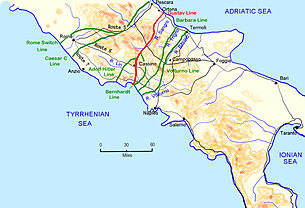Volturno Line

The Volturno Line (also known as the Viktor Line) was a German defensive position in Italy during World War II.
The line ran from Termoli in the east, along the Biferno River through the Apennine Mountains to the Volturno River in the west.
Following the Allied invasion of Italy the German forces set up a series of defensive lines across Italy, intended to delay the Allied advance. The Volturno Line was the southernmost of these.
8th Army on the River Biferno (Battle of Termoli)
On the Adriatic coast elements of the British 78th Infantry Division's 11th Brigade infantry crossed the Biferno at dawn on October 3, 1943 following an amphibious landing at Termoli by Commandos at 0215.[1] By late morning the two elements had linked up and that night 78th Division's 36th Brigade were able to be landed by sea at Termoli. However, logistical problems had prevented the Allies building a heavy duty bridge across the Biferno and when the bulldozed fords were washed away by heavy rains that evening there remained no way to get tanks across the river to support the infantry. On hearing of the landings at Termoli, the German supreme commander in Italy, Field Marshall Albert Kesselring, ordered the 16th Panzer Division to switch to the Adriatic front, presenting a major threat to the unsupported Allied infantry. As news of the German armour's arrival came in on 4 October, 78th Division's commander, Major-General Evelegh, demanded priority from 8th Army resources for bridging equipment.[2] As more German armour arrived, the Allied troops across the Biferno were forced onto the defensive. By the afternoon of 5 October they had been squeezed back to within half a mile of Termoli.[3] However, at the same time frantic round the clock efforts by engineers had resulted in a heavyweight Bailey bridge being completed allowing Canadian and British armour across the Biferno. That evening 78th Division's 38th (Irish) Brigade arrived by sea at Termoli and the German attack the following morning was narrowly repulsed in desperate fighting. By late morning on 6 October, the Allies were on the attack and by late afternoon the Germans had started to fall back to the next prepared defenses on the River Trigno, the Barbara Line.[4]
5th Army on the River Volturno

On the other coast the U.S. 5th Army attacked across the Volturno on the night of October 12.[5] The Germans using rearguard tactics skillfully using the terrain which was favourable for defence, retreated to the next line north (the Barbara Line) which the Allies reached by 2 November.
Bibliography
- Clark, LLoyd (2006). Anzio: The Friction of War. Italy and the Battle for Rome 1944. London: Headline Publishing Group. ISBN 978 0 7553 1420 1.
- Fifth Army Historical Section (1990) [1945]. From the Volturno to the Winter Line 6 October-15 November 1943. American Forces in Action series. Washington: United States Army Center of Military History. ISBN 0-16-001999-0. CMH Pub 100-8.
- Ford, Ken (2003). Battleaxe Division. Stroud, Gloucestershire: Sutton. ISBN 0-7509-1893-4.
{{cite book}}: Unknown parameter|origdate=ignored (|orig-date=suggested) (help) - Smith, Col. Kenneth V. (1990?). Naples-Foggia 9 September 1943-21 January 1944. World War II Campaigns. Washington: United States Army Center of Military History. CMH Pub 72-17.
{{cite book}}: Check date values in:|year=(help)
References
See also
